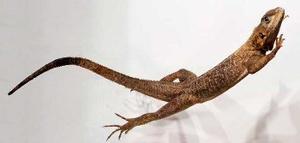RoboticsTails help leaping lizards – and robots – stay in control
A new study examined how lizards manage to leap successfully even when they slip and stumble; the researchers found that lizards swing their tails upward to prevent them from pitching head-over-heels into a rock; the research pushed the boundaries of control in robotics in an area researchers call inertial assisted robotics

When jumping, the lizard adjusts tail position to maintain correct flight attitude // Source: berkeley.edu
University of California, Berkeley, biologists and engineers, including undergraduate and graduate students, studied how lizards manage to leap successfully even when they slip and stumble. They found that lizards swing their tails upward to prevent them from pitching head-over-heels into a rock.
After the team added a tail to a robotic car named Tailbot, they discovered that counteracting the effect of a slip is not as simple as throwing your tail in the air. Instead, robots and lizards must actively adjust the angle of their tails just right to remain upright. “We showed for the first time that lizards swing their tail up or down to counteract the rotation of their body, keeping them stable,” said team leader Robert J. Full, UC Berkeley professor of integrative biology. “Inspiration from lizard tails will likely lead to far more agile search-and-rescue robots, as well as ones having greater capability to more rapidly detect chemical, biological or nuclear hazards.”
Agile therapod dinosaurs like the velociraptor depicted in the movie Jurassic Park may also have used their tails as stabilizers to prevent forward pitch, Full said. Their tail movement is illustrated in a prescient chase sequence from the 1993 movie in which the animated animal leaps from a balcony onto a T. rex skeleton.
“Muscles willing, the dinosaur could be even more effective with a swing of its tail in controlling body attitude than the lizards,” Full said.
A University of California-Berkeley release reports that Full and his laboratory colleagues, including both engineering and biology students, reported their discoveries online on 4 January in advance of publication in the 12 January print edition of the journal Nature. The paper’s first author, mechanical engineering graduate student Thomas Libby, also will report the results on 7 January at the annual meeting of the Society for Integrative and Comparative Biology in Charleston, South Carolina.
Full is enthusiastic about the interplay fostered at UC Berkeley between biologists and engineers in the Center for Interdisciplinary Bio-inspiration in Education and Research (CiBER) lab, within which he offers a research-based teaching lab that provides dozens of undergraduate students with an opportunity to conduct cutting-edge research in teams with graduate students. Each team experiences the benefits of how biologists and engineers approach a problem.
“Learning in the context of original discovery, finding out something that no one has ever know before, really motivated me,” said former UC Berkeley integrative biology undergraduate Talia Moore,
